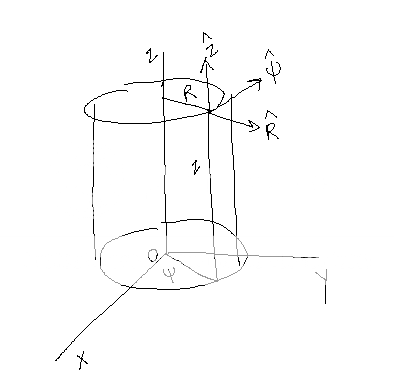1) Show that the unit vectors R hat, psi hat, z hat have cartesian components given by
R hat=(cosΨ,sinΨ,0)
Ψ hat=(-sinΨ,cosΨ,0)
z hat=(0,0,1)
and also that the curved surface of the cylinder in the Figure has the line element ds, where
ds^2=a^2dΨ^2 + dz^2,
and a is the radius.
If anyone needs the picture:

I got the cartesian components. I have a question about the line element.
For R, I have magnitude 1
for Ψ, magnitude is R
for z, magnitude is 1
When solving for line element, I ended up with
ds^2=(∂ r/∂ R)^2(dR)^2 + (∂ r/∂ Ψ)^2(dΨ)^2 + (∂r/∂z)^2(dz)^2 + ... (the other stuff that tends to zero because R, Ψ, and z are orthogonal to each other)
ds^2=1(dR)^2 + R^2(dΨ)^2 + (dz)^2
answer does not have dR^2 included. Why?
2) If you have cross product:
∂r/∂θ x ∂r/∂Ψ = a^2(sin^2θ cosΨi + sin^2θ sinΨj + sinθcosθk)
and so
|∂r/∂θ x ∂r/∂Ψ| = a^2(sin^4θ + sin^2θ cos^2θ)^(1/2) = a^2 sinθ
I got the answer for ∂r/∂θ x ∂r/∂Ψ, but not for the absolute value of it.
If I took the scalar of the vector:
sin^2θ cosΨi + sin^2θ sinΨj + sinθcosθk
I would end up with the answer for the absolute value.
Is that the correct way to get the answer? Why?
If it is not the correct way to get it, how else would you get it?
*He only stated the answer with no explanation.
3) For evaluation of flux through a surface,
I have trouble seeing how vector (∂f/∂x, ∂f/∂y, ∂f/∂z) is normal to the surface. How does a vector like this looks like?
4) If you have variables x and y, and you introduce polar coordinates R and Ψ into them, so that
x = RcosΨ
y = RsinΨ
then dxdy = RdRdΨ
Why is it RdRdΨ? Why can't it be dxdy = (dR)^2 (dΨ)^2?
5) Find flux of vector field F=zj-k through surface x=sinu cosv, y=sinu sinv , z=cos^2 u, where 0 ≦u ≦0.5pi, 0 ≦v < 2pi.
He did
dScos(n hat, k) = dSn hat . k = dxdy
doing this makes calculating flux automatically measured in the normal direction with k component.
I don't see how this is so. I also don't see why he did cos(n hat, k). And why when he takes
integral F.dS, he takes it by the value of S, but when he does double integral, he does it on So (s knot?), where So is a particular point on the surface (??)...
Is it just that integrating one time to the value of S is just standard to write it that way, but when you really solve for it with double integral, the So gives the parameters of the integral? So it's just standard way of writing?
I also have trouble picturing how vectors like
(∂f/∂x, ∂f/∂y, ∂f/∂z) look like on a graph
or
df = (∂f/∂xdx + ∂f/∂ydy + ∂f/∂zdz) look like on a graph. Are we supposed to remember that
(∂f/∂x, ∂f/∂y, ∂f/∂z) is always normal to surface
and
df = (∂f/∂xdx + ∂f/∂ydy + ∂f/∂zdz) is always tangential to surface at some point?
Or do I have this wrong?
Any answer to any of the questions would be appreciated. I know it's a long list of questions.
Thank you to anyone who helps.

